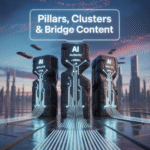The Psychology of Urgency: How AI Can Help You Sell Faster
Most buyers don’t make decisions because something is good. They make decisions because they feel like they’ll miss out if they don’t.
Urgency is the pressure that tips hesitation into action. But too many marketers confuse pressure with manipulation.
They slap countdown timers on sales pages or say “only 3 spots left” when that’s not true. That kind of urgency gets ignored or resented.
It’s performative, not persuasive.
Real urgency works because it aligns with the way people think.
It taps into loss aversion. It plays on limited attention spans. It accounts for decision fatigue.
It knows that people procrastinate by default, even when they want something. That’s what urgency fixes. It doesn’t convince them to want the offer.
It gives them a reason to want it now.
The best kind of urgency doesn’t feel like pressure. It feels like clarity. A reason to stop thinking and start moving.
And AI can help you build that into your strategy without being shady.
It gives you speed, variation, and personalization—three things that make urgency more believable and effective.
Start with emotional triggers.
Prompt:
“List 10 urgency angles based on emotional motivators like fear of missing out, anticipation, momentum, or exclusivity.”
You’ll get reminders that people don’t want to be left behind.
They want to be part of something new. They don’t want to overthink. They want to respond to timing.
Then prompt:
“Write 3 email subject lines for each angle that would get a hesitant buyer to click.”
Now you’ve got urgency rooted in psychology, not gimmicks.
You can also prompt for variations across platforms.
“Write 3 tweet-style headlines using urgency that highlight the time-sensitive benefit of my offer.”
Or,
“Give me 5 short video scripts that create a sense of now-or-never energy without sounding pushy.”
This is what most marketers never do. They write one version of urgency, rinse and repeat it across everything, and wonder why no one responds.
AI can spin dozens of variations in minutes. That gives you space to test and adapt fast.
Scarcity is part of urgency, but it only works when it’s real. Don’t lie about quantity. Instead, focus on timing.
Prompt:
“Create a 3-day promo sequence that ramps urgency each day, using different angles like buyer momentum, missed opportunity, and stacking bonuses.”
This type of urgency builds instead of blasts. It gives people reminders. It shows growing interest. It doesn’t just shout “last chance” with a siren gif.
You can use AI to generate urgency-infused bonus stacks too.
“Write 5 time-sensitive bonuses that expire after the weekend and tie directly into the core product’s results.”
Or,
“Create a 24-hour bonus that rewards action takers without punishing those who need more time.”
This keeps your urgency from feeling like pressure. It becomes a reward instead. And people respond to rewards with far less hesitation.
Urgency also works when it’s personalized. If someone’s on your list and hasn’t clicked, you can prompt:
“Write a follow-up email to someone who saw the offer but didn’t buy. Make it feel like a gentle nudge with a clear reason to act now.”
You don’t need to hammer them. You need to make it easier to say yes.
You can use AI to audit your pages too. Paste your sales page into a prompt and ask:
“Where can I add urgency without sounding hypey? Suggest specific lines or CTA improvements.”
Then do the same for emails, blog posts, or video scripts. The more touchpoints you optimize, the more chances you give people to stop stalling.
AI can also help you reverse-engineer buyer hesitation.
Prompt:
“What are 10 common reasons people delay buying digital products, and how can I counter each with urgency-based messaging?”
This tells you exactly what they’re afraid of—spending money, not finishing, not getting results, needing to ‘think about it.’ You can then respond with messaging like, “This isn’t a lifetime decision. It’s a fast-track to see if this fits,” or “You don’t have to finish it all at once. You just need to start.”
Urgency doesn’t mean pressuring people who aren’t ready. It means serving the ones who already want it but haven’t acted yet. They’re the ones that urgency helps the most. And AI gives you the language, structure, and sequence to reach them before they drift.
You can even create urgency around habits.
Prompt: “Write 3 daily challenges that help my audience implement part of my offer with visible results in 24 hours.” If you build momentum inside your product, you create urgency to stay. Retention is just another form of action.
For sales campaigns, ask: “Give me a 5-day urgency timeline with emails, social posts, and short videos that build pressure naturally from curiosity to countdown.” Now you’re not throwing urgency at the end. You’re embedding it from the beginning. Buyers feel it coming, but not in a way that stresses them out.
The biggest mistake marketers make is thinking urgency needs to scream. The best urgency whispers. It reminds. It reveals. It nudges. AI helps you hit that tone in 20 different ways without sounding like a broken record. It lets you use phrases like, “This is the last time it’ll be offered at this price” or “We’re pulling it after this weekend to focus on new projects” without needing to fake scarcity or lie.
When urgency is rooted in honesty, it works better. When it’s thoughtful instead of loud, it lands deeper. And when it’s built into every touchpoint—your content, your offers, your CTAs—it becomes part of your marketing rhythm, not a one-time tactic.
Ask AI to help you plan that rhythm. “Create a monthly promo calendar that includes urgency-based angles each week to keep engagement high without burning out my list.” That kind of planning pays off. It makes sure your urgency doesn’t become noise. It keeps it strategic, spaced, and sustainable.
Use AI to generate urgency triggers that fit your brand voice. Prompt: “Here’s how I write. Suggest 10 urgency statements that feel aligned, not over-the-top.” Don’t settle for swipe copy that sounds like everyone else. Get urgency that sounds like you and still converts.
Urgency is a tool, not a trick. It’s about timing, clarity, and pacing. It’s about knowing your buyers are already distracted, already overwhelmed, and already skeptical. It gives them a reason to make the decision now before life pulls them in another direction. And AI helps you find that message faster, write it sharper, and deploy it with more consistency.
You don’t need to outsmart your audience. You need to help them stop delaying a decision they already want to make. Urgency removes friction. That’s what AI should be helping you do every day.
Prompt smarter. Build faster. Close easier. AI can help you do all three. You just need to stop guessing and start using it like the strategic partner it is. Start small. One email. One CTA tweak. One bonus rewrite. Use urgency that respects your buyers but still moves them to act. Then keep going.
Buyers don’t hate urgency. They hate being tricked. If you use it honestly and frequently with help from AI, you’ll stop watching people sit on the fence and start watching them step over the line. That’s what turns content into conversions. Offers into income. And marketing into momentum.









0 Comments